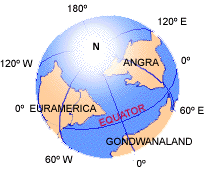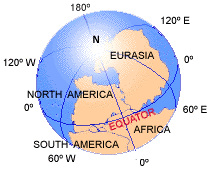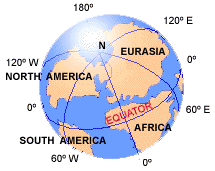MOVING CONTINENTS |
|---|
MOVING CONTINENTS |
|---|

of WEST VIRGINIA LIVED |
Floating atop a mantle of hot, ductile rock, the continents and ocean plates drift like gargantuan icebergs, crashing into each other, building mountain ranges and volcanic belts as they go. The phenomenon is known as continental drift and the process has been going on for hundreds of millions of years-- at rates measured in only a few centimeters per year. Two types of rocks comprise Earth's outer crust:
Oceanic crust is being continuously created through the process of seafloor spreading, and continuously consumed through subduction. Because of this continuous recycling, no oceanic crust is older than 190 million years. See an animation of subduction in action. Continental crust is generally not recycled through subduction. Consequently the rocks in the middle of continents can be more than 2.5 billion years old. The age of the rocks generally decrease toward the continental margins, representing lands added to the original continental core throughout geologic time by processes like convergence and continental acretion. See an animation of convergence in action.
|

|
The first dinosaurs evolved during the Triassic Period as all the continents converged to form a single giant supercontinent called Pangea.
The continents also traded bits and pieces of each other along the way. Florida and parts of Georgia and South Carolina, for example, are left-behind fragments of African Gondwanaland. |

BECAME EXTINCT |
By the end of the Cretaceous Period the dinosaurs had all but vanished from the face of the earth.
The concept of moving continents, once scoffed at by geologists, has today become generally understood and almost universally accepted. Although proposed nearly a century ago, continental drift became accepted only after intriguing evidence from mapping of undersea mountain ranges during World War II and subsequent studies of the ocean floor and continental margins produced nearly irrefutable evidence. Just what produces the awesome forces that can split and move the continents is still an ongoing process of discovery today. The study of continental drift, it's history and the forces that cause it, constitutes the branch of geology known as Plate Tectonics. |
Additional Reading:
| Mountain Maker, Earth Shaker | Produced by PBS. A very good introduction to Plate Tectonics, with several interesting GIF animations. |
| The Dynamic Earth: The story of Plate Tectonics | Presented by the United States Geological Survey. A good informational and graphic resource providing a more in- depth and technical explanation of continental drift and other earth forces. |
Articles || Table Of Contents || Next NARRATIVE AND GRAPHICS BY:
Monte Hieb and Nancy HiebThis site last updated November 18, 2000
CREDITS:
Animated Breakup of Pangea During the Mesozoic & Cenozoic Eras (150 million years to Present Day) courtesy of: GEOMAR, Research Center for Marine Geosciences / Kiel and the Geological Institute of the University Bremen